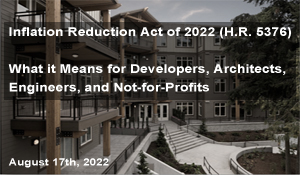Inflation Reduction Act Post – Changes for Real Estate Developers, Design-Build Contractors, Architects, Engineers, and Not-for Profits
On Tuesday, August 16th, 2022, the President signed into Law the Inflation Reduction Act of 2022 (H.R. 5376). This is a sweeping $740 billion tax, climate, and health care law and has been championed as a “climate change law”, but it also allocates hundreds of billions of dollars over the next decade to several programs intended to reduce inflation. In essence, the legislation is a scaled-down version of the Build Back Better Act proposed by the Biden administration in 2021.
Changes for Real Estate Developers, Design-Build Contractors, Architects, Engineers, and Not-for Profits
§179D Energy-Efficient Building Tax Deduction
Originally, the Energy Policy Act of 2005 created §179D which allows property owners and designers of government buildings a significant federal tax deduction for the costs of installing energy efficient lighting, HVAC, and/or building envelope systems in commercial and government buildings. The §179D tax deduction offers up to $1.80 per square foot for improving the energy efficiency of existing commercial buildings or designing efficient new buildings placed in service between January 1st, 2006 and December 31st, 2020.
In December of 2020, this tax deduction was made permanent, and the maximum tax deduction was capped at $1.88 per square foot of affected building space.
The new law both expands the scope and impact of the §179D tax deduction. Beginning January 1st, 2023, the maximum allowable benefit increases from $1.88 per square foot to $5.00 per square foot of building area.
Also, starting in 2023, architects, engineers, and design-build contractors are now eligible to receive allocations for their work on tax-exempt entities. The expanded list includes:
· Tribal Governments,
· Charitable organizations,
· Churches and religions organizations,
· Private schools & universities,
· Private foundations, and
· Political organizations.

§45L Energy-Efficient Home Credit
In addition to the Energy Policy Act of 2005 creating the §179D Energy Efficient Building Tax Deduction, it also created the §45L Energy Efficient Home Credit, to promote the construction of new, energy efficient single-family homes and low-rise residential buildings. The Energy Efficient Home Credit provides eligible contractors with a $2,000 tax credit for each residential unit that meets the energy threshold requirements. Manufactured homes are eligible for a $1,000 credit. Under the latest extension, under the Consolidated Appropriations Act of 2021, (H.R. 133), this credit expired at the end of 2021.
Under the new law, it is extended through December 31, 2032 and is now available for tax year 2022 utilizing the same credit amount and methodology from previous years.
Beginning in 2023, the Act provides an increased §45L tax credit of $2,500 for single family and manufactured homes when constructed according to the standards set by the ENERGY STAR Residential New Construction Program or the Manufactured Homes Program.
· Single-family homes must meet the ENERGY STAR Single Family New Homes Program, Version 3.1 for homes constructed before January 1, 2025 and Version 3.2 thereafter.
· Manufactured homes must meet the latest ENERGY STAR Manufactured Home National Program requirements as in effect on the latter of January 1, 2023 or January 1 of two calendar years prior to the date the dwelling is acquired.
The Act also provides an even higher §45L tax credit of $5,000 for single family and manufactured homes when they are certified as a DOE Zero Energy Ready Home (ZERH).
For multifamily homes constructed after 2022, the Act provides a §45L tax credit of $500 when meeting the ENERGY STAR Single Family New Homes Program or $1,000 when homes are certified as a ZERH. Additionally, the low-rise requirement has now been removed, and buildings over three stories will qualify for this credit.
Additionally, starting January 1, 2023, homebuilders must satisfy the prevailing wage requirements.
Green Summit Engineering Insight: Under the new law, Apartment developers can now claim the §179D Energy Efficient Building Tax Deduction, up to $5.00 per square foot, AND, the §45L Energy Efficient Home Credit, up to $1,000 per apartment unit, when all requirements are met.
Other Major Changes in the New Act Under Title I
15% Corporate Minimum Tax
The new law imposes a 15% minimum tax on corporations (excluding Subchapter S corporations, regulated investment companies, and real estate investment trusts). The tax applies to companies that generate $1B in annual earnings, over a specified 3-year period. The Joint Committee on Taxation (JCT) estimates the tax will raise $222 billion in revenue over the next decade. This new tax rate is effective in taxable years beginning after December 31, 2022.
Excise Tax on Repurchase of Corporate Stock
The new law imposes a 1% excise tax on the fair market value of stock repurchased by a domestic corporation after 2022, with certain exceptions.
Enhanced IRS Tax Enforcement
The Act allocates $80 billion to increase enforcement by the IRS, including for operations support, business systems modernization, and the development of a free direct e-file tax return system. It also provides additional funding for the Department of the Treasury Inspector General for Tax Administration, the Office of Tax Policy, the Tax Court, and Treasury departmental offices.
Prescription Drug Pricing Reform
The new law allows Medicare to negotiate prices for some drugs for the first time. Specifically, the new law will allow Medicare to negotiate prices for 10 higher-cost drugs starting in 2026. This would increase to 20 drugs by 2029. Companies that deny negotiations will be subject to a 95% maximum sales tax on that drug. The new Law includes a ceiling on the negotiated price of the specified drug. The new law also caps out-of-pocket spending for insulin costs for people on Medicare at $35 per month.
Prescription Drug Inflation Rebates
The new law requires drug manufacturers to issue rebates to the CMS for brand-name drugs without generic equivalents under Medicare that cost $100 or more per year per individual and for which prices increase faster than inflation. Manufacturers that fail to comply are subject to civil penalties.
Part D Improvements and Maximum Out-of-Pocket Cap for Medicare Beneficiaries
The new law eliminates beneficiary cost-sharing above the annual out-of-pocket spending threshold under the Medicare prescription drug benefit beginning in 2024 and caps annual out-of-pocket spending at $2,000 in 2025 (with annual adjustments thereafter). It also establishes a program under which drug manufacturers provide discounts to beneficiaries who have incurred costs above the annual deductible beginning in 2025.
Continued Delay of Implementation of Prescription Drug Rebate Rule
The law further delays until 2032 implementation of a Department of Health and Human Services rule relating to the treatment of certain Medicare prescription drug benefit rebates from drug manufacturers for purposes of federal anti-kickback laws.
Affordable Care Act Subsidies
The law extends through 2025 certain adjustments and expansions of the premium tax credit, including to allow taxpayers with income above 400% of the federal poverty line to qualify for the credit.
Energy Security
The law modifies and extends through 2024 tax credits:
· for producing electricity from renewable resources, specifically for wind, biomass, geothermal and solar, landfill gas, trash, qualified hydropower, and marine and hydrokinetic resources;
· for investment in certain energy properties (e.g., solar, fuel cells, waste energy recovery, combined heat and power, small wind property, and microturbine property); and
· for alternative fuels and fuel mixtures, and biodiesel and renewable diesel.
The law creates new tax credits for:
· qualifying zero-emission nuclear power produced and sold after 2023,
· the sale or mixture of sustainable aviation fuel beginning in 2023,
· the production of clean hydrogen,
· the production of clean electricity and for investment in zero-emissions electricity generation facilities or energy storage technology,
· domestic clean fuel production beginning in 2025, and
· the domestic production and sale of qualifying solar and wind components.
The law modifies and extends through 2032:
· the tax credit for nonbusiness energy property and increases its rate to 30%, with certain limitations;
· the new energy efficient home credit; and
· the tax credit for alternate fuel refueling property expenditures.
· The law modifies requirements for the tax deduction for energy efficient commercial buildings.
The law creates a new credit for commercial clean vehicles and modifies the refundable tax credit for the purchase of plug-in electric vehicles and previously-owned electric vehicles.
The law permanently reinstates the Hazardous Substance Superfund financing rate for certain excise taxes, including the excise tax on domestic crude oil and imported petroleum products at the rate of 16.4 cents per barrel in 2023, adjusted annually for inflation.
The law makes permanent the increased rate of the coal excise tax for funding the Black Lung Disability Trust Fund.
The law increases the amount of the research tax credit that may be applied against the payroll tax liabilities of certain small businesses.
The law reinstates the current suspension until 2025 of the tax deduction for state and local taxes and extends the limitation on excess business losses of noncorporate taxpayers.

